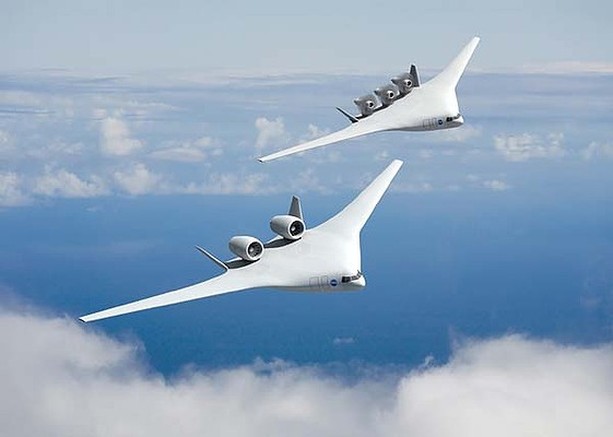|
NASA has revealed a sneak peek at how we may be travelling in the year 2025. Last year, the US space agency awarded contracts to three teams - Lockheed Martin, Northrop Grumman and Boeing - to study advanced concept designs for aircraft of the future. Their brief was a difficult one: to create aircraft that delivered less noise, cleaner exhaust and lower fuel consumption than today's planes, while still being able to achieve speeds up to 85 per cent of the speed of sound; cover a range of approximately 11,000 kilometres; and carry between 50,000 and 100,000 pounds (22,600 and 43,200 kilograms) of payload, either passengers or cargo. "Each aircraft has to be able to do all of those things at the same time, which requires a complex dance of tradeoffs between all of the new advanced technologies that will be on these vehicles," NASA said on its website. The companies' designs vary greatly. The Boeing aircraft looks similar to a military stealth bomber, while Lockheed Martin's design looks more like a modern-day airliner. Northrop Grumman's twin-fuselage design has similarities with Virgin Galactic's WhiteKnightTwo, the mothership for launching passenger spacecraft. The only thing all three had in common was the disappearance of engines from the outer wings. Both Boeing and Lockheed Martin moved engines to the tail of the plane, while Northrop Grumman's engine sat between the two fuselage. NASA said the companies would continue to work on the design this year. “For the rest of this year, each team will be exploring, testing, simulating, keeping and discarding innovations and technologies to make their design a winner," NASA said. The project is sponsored by NASA's Environmentally Responsible Aviation Project. It follows on from an earlier project that looked 10 years further in to the future, inviting aircraft designers to offer concepts for how we might be flying in 2035. See More Photos: The aircraft of the future Original Article: http://www.theage.com.au/travel/travel-news/nasa-unveils-aircraft-of-the-future-20110118-19uus.html  The Hybrid Wing Body H-Series design by the Massachusetts Institute of Technology. Hybrid Wing Body H-Series future aircraft design concept comes from the research team led by the Massachusetts Institute of Technology. It features embedded engines using variable area nozzles with thrust vectoring. Photo: NASA/MIT/Aurora Flight Sciences
0 Comments
Your comment will be posted after it is approved.
Leave a Reply. |
News Watch
Mind-opening news articles, editorials, videos & apparel that inspire our readers and help liberate them from the status quo. Stay informed.
Write For UsSpace WatchTop NewsNews Watch Categories
All
|
|
|
HAVE A TIP OR STORY TO TELL? JOIN TODAY & SHARE YOUR STORY!
If you have a breaking news tip or idea, please email: [email protected] Apparently Apparel® is a registered trade name and part of the ZOAT International® brands network. © 2007-2023. All Rights Reserved. Privacy Policy. All art & news content posted on this site is commentary or opinion and is protected under Free Speech. ApparentlyApparel.com is not responsible for content written by contributing artists, authors or news feeds. The information on this site is provided for educational and entertainment purposes only. It is not intended as a substitute for professional advice of any kind. ApparentlyApparel.com assumes no responsibility for the use or misuse of this material.
|
|








